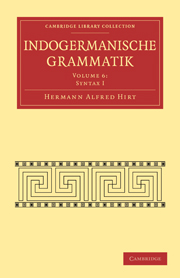I - Numerus und Geschlecht
Published online by Cambridge University Press: 05 August 2011
Summary
Vorbemerkung. Der Numerus findet sich beim Substantivum, Adjektivum, Pronomen und Verbum, das grammatische Geschlecht bei den ersten drei Kategorien, aber nicht beim Verbum. Daher empfiehlt es sich, diese beiden Kategorien voraus zu nehmen.
Der Ausdruck der Zahl. Wenn uns mehrere Gegenstände entgegentreten, so bleibt das natürlichste, sie zu zählen, oder sie mit einem Wort als nicht zählbar zu bezeichnen (viel, einige, manche). Flexionsformen zu gebrauchen, ist nicht gerade notwendig.
Das Indogermanische in der Zeit vor der Trennung und die Einzelsprachen driicken aber das Zahlenverhaltnis im allgemeinen durch flektierte Formen aus, und zwar besitzen wir beim Nomen, Pronomen und Verbum drei Numeri, einen Singular, einen Dual und einen Plural, von denen natürlich auch anzunehmen ist, daß sie sich entwickelt haben. Wir können dies tatsächlich verfolgen.
Der Dual. Für den Ausdruck der Zweizahl besitzen wir heute zwei Ausdrücke: einerseits die Zahl zwei, mit der wir beliebige zwei Gegenstände bezeichnen, und den Ausdruck beide, das irn allgemeinen zwei zusammengehörige Gegenstände bezeichnet. Beide Ausdrücke sind idg.
Zwei: gr. δύω, 1. duo, d. zwei usw. weist wohl auf die 2 hin, die aus der 1 entstanden ist. Vgl. entzwei, Zweig, 1. dis, d. zer, gr. διά. […]
- Type
- Chapter
- Information
- Indogermanische Grammatik , pp. 17 - 29Publisher: Cambridge University PressPrint publication year: 2009First published in: 1934



